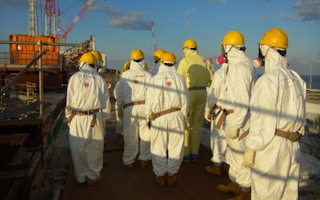There have been three well-documented major nuclear accidents in the last 60 years, each one accompanied by official lies and cover-ups. There have been other less well-known serious accidents that have been so effectively hushed up that decades later there are only the sketchiest details available.
The legacy of these disasters is a deep distrust of the industry by many voters. In some leading industrial countries this has led to governments being forced to abandon nuclear power altogether, while others face such strong opposition to new stations being built that they have abandoned the idea, although they still keep the old ones operating, at least for now.
This chequered history of the industry matters. It has caused a global split. While many scientists and politicians concerned about climate change believe that nuclear power is vital if governments are to meet their commitments to curb dangerous global warming, just as many do not.
The opposition is based on the belief that the industry has lost all integrity and credibility and that renewables are a cheaper, safer and all-round better bet.
This view is reinforced by the inability of the industry to deal with its waste. Renewables can easily be recycled, but nuclear waste remains dangerous for thousands of years, leaving future generations to pay for it.
But it is the three major disasters that are at the root of this fierce debate. They happened over a span of 60 years, and all had different causes. But all followed a familiar pattern.
The first was at Windscale in north-west England in 1957, when a plutonium-producing reactor caught fire. The second was Chernobyl on the border of Ukraine and Belarus in 1986: the top blew off one of the reactors and there was a serious fire. The third was at Fukushima in Japan in 2011, when an earthquake and a tsunami caused meltdowns at three reactors.
Official concealment
All three accidents had startling similarities in the official reaction. In each case the governments involved, the nuclear regulators and plant owners tried to hide the scale of the disaster from the public who were most in danger. In each case this resulted in unnecessary exposure of the population to harmful radiation.
Second, the possible long-term health effects to the people involved were hotly disputed. In each case this took the form, both at the time and ever since, of governments and the industry playing down the health risks.
There is still an argument about whether the Windscale fire caused a leukaemia cluster in children in the neighbourhood. After Fukushima, governments and the industry claim, very few or no deaths at all resulted. Expect the argument to continue for decades.
Third has been the underplaying of the enormous cost and intractable nature of trying to clean up the mess. For example, people who are evacuated are told the move is only temporary, when it could last for decades, possibly generations.
Again, the official estimate for “compensation” for the Fukushima accident rose from ¥5.4 trillion (£40bn) to ¥8 trillion (£70bn), a fact only slipped out at the end of November 2016, nearly five years after the accident.
Technically insurmountable
In each case, even after the Windscale accident 60 years ago, the clean-up of the actual nuclear pile that caught fire has several times started and then been abandoned as too difficult. They are not expected to be completed for decades.
There is no hope of cleaning up Chernobyl or Fukushima this century. A new concrete shell over Chernobyl to replace the existing crumbling structure should be in place by 2017 at a cost of €2.1 – but this is designed only as a temporary structure, to last 100 years.
Governments tried hard to cover up what happened. At Windscale, the British government subsequently admitted it had deliberately covered up the seriousness of the accidents to keep its nuclear weapons programme on track.
In Chernobyl’s case it was the sky-high radiation readings from as far away as Scandinavia and Germany that led the Soviets to admit what had happened. Thirty years later the real health effects of the accident are hotly disputed.
Thousands of children have had their thyroids removed and there have been many birth defects and cancers. Belarus, worst hit by the disaster, is anxious to play down the long-term effects to avoid frightening potential foreign investors in the country.
The nuclear industry has been trying hard to put all this in the past. In response to public concerns it has come up with a whole series of “safer” designs for nuclear power stations. As a result, some countries like Finland and Britain are encouraging the building of a new generation of French, Japanese, Chinese and American designs.
This story was published with permission from Climate News Network. Read the full story.










